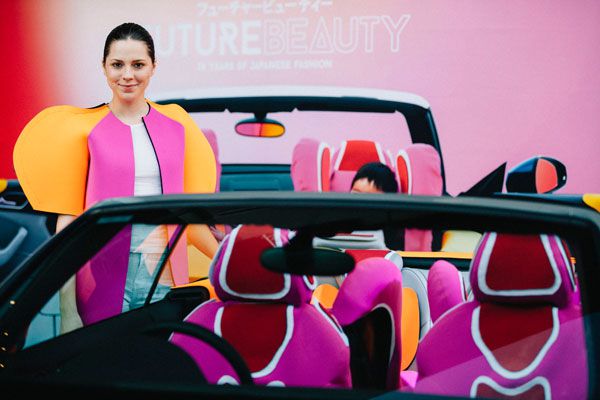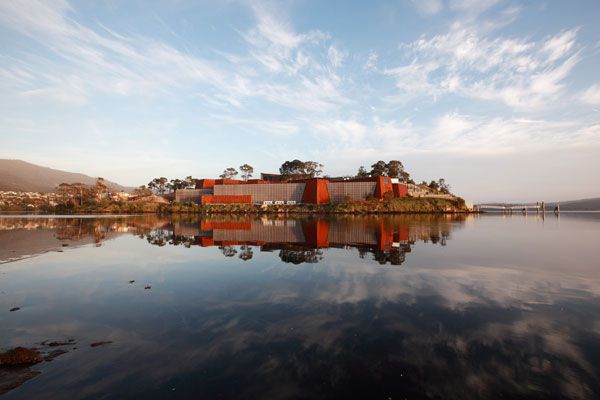Looking at Audi’s major art sponsorships, Tess Ritchie asks how the design and arts industries create mutually beneficial relationships through Sponsorship.

February 26th, 2015
Above: A3 Cabriolet designed for ‘Future Beauty: 30 years of Japanese Fashion at GOMA’. Image by Joe Ruckli
Gone are the days where sponsorship is “getting a cheque in the mail and mentioning the sponsors name at the opening event” – as Director at Queensland Gallery of MOdern Art (GOMA) Chris Saines puts it. Today, both sponsor and beneficiary expect much more from a partnership and the benefits must be equally satisfying. So what exactly does a successful sponsorship partnership look like? How do brands from different industries, specifically the design and arts industries, create a mutually beneficial relationship?
Audi’s major art sponsorships with MCA, GOMA and MONA is a helpful place to start. Sponsorship is crucial to the livelihood of each company and the results have been satisfying. Chirs Saines is quick to link much of the success of GOMA’s programs to their sponsors, saying “we couldn’t deliver what we do to the public without this really crucial kind of financial support. Not at the reach and level of ambition we do”. We are “immensely proud to be associated with Audi,” he says. Similarly, MCA’s ArtBar series, developed with Audi, has enabled curators to do new and exiting things like stage a cat café and a BMX demo and is a “highly regarded” event, says Director of Enterprises and Development Martin Barden.

Above: ARTBAR images from January’s event. Image by Lucy Parakhina
For Audi, partnering with Australia’s premiere contemporary art institutions helps build the brand “in a premium way,” says General Manager of Corporate Communications Anna Burgdorf, “because we are able to support these industries/assets and create community engagement, host our customers and generate new relationships with prospects.” Significantly, the partnerships enable ‘money can’t buy’ interactions – which are crucial to Audi’s brand.
So what makes these partnerships so fruitful? First, there “strong intersecting brand values” need to exist. “Getting value propositions to align is one of the cornerstone things that you need to consider for a productive sponsorship relationship,” says Saines. As well as a standard sponsorship policy, GOMA have to “decide whether it’s a sponsor alignment or association” they want to have. Audi is a perfect case in point, says Saines, because “their goal to be the leader in their field aligns with our goal to be the major institution for contemporary art in Australia Asia and the pacific.”

Above: ARTBAR images from January’s event. Image by Lucy Parakhina
Similarly thoughtful, MCA “look for true partnerships where [they] can work collaboratively and innovatively, and for the long term” and MONA looks at them “as meaningful partnerships”; these are no superficial decisions. As Creative Director of MONA and Dark Mofo Leigh Carmichael says, “we do not partner with brands we don’t like, respect or enjoy working with.”
In the same way, Audi’s partners must resonate with the Audi brand and customers, their investment in the arts a prime example. “Our German heritage connects us with the arts but it’s also a clear interest for our buyers,” says Burgdorf. Committed to being the No. 1 premium brand worldwide, partnering with contemporary art galleries – innovative and sophisticated at the same time – makes sense.
As for the actual workings of the campaign, two things stand out: planning and working closely together. From identifying goals and objectives, through to being on the ground and evaluating results, sponsorship must be a team effort. Both the galleries and Audi want to give their audience the best programs possible and that means working together. “Primarily the sponsorship is that it’s an enabler – it allows us to market exhibitions into market places well beyond Brisbane,” says Saines, “but were also looking for mutual benefits. So we try and do things that are really integrated in terms of sponsors interest, also promoting them into the markets where they want to have visibility every bit as much as we do.”

Above: A3 Cabriolet designed for ‘Future Beauty: 30 years of Japanese Fashion at GOMA’. Image by Joe Ruckli
For Future Beauty: 30 years of Japanese Fashion at GOMA, among other things, an A3 Cabriolet was turned into a work of art, drawing on ideas of progressive design, perception of beauty, and the future as a way to engage both brands. Audi is clearly not interested in being just “another car brand attaching [their] logo”. Another example is MCA’s ARTBAR driven by Audi – a night once a month where an entire wing is taken over by music, performance, multimedia and design, curated by one artist, which reflects Audi’s values of sophistication and progress, while being entirely appropriate for MCA. The result has been successful “brand awareness for Audi” and “a loyal, highly engaged audience” for MCA.

Above: MONA Museum of Old and New Art. Southern facade viewed from Little Frying Pan Island, south of the museum. Photo credit: MONA/Leigh Carmichael. Image courtesy of MONA Museum of Old and New Art, Hobart, Tasmania, Australia
As Saines reminds us, engaging in sponsorship is a “business decision” from both parties. “[Sponsors] are not charitable donors,” he says. “They’re making a business decision to invest their support in us, and in turn, we’re making a business decision to accept that support and to reciprocate with a range of benefits that are hopefully of value to them.”
It’s clear that a mutually beneficial relationship through sponsorship depends on a few things: shared values, thoughtful strategies and creative thinking – as well as passion. “There’s a lot of head there but there’s also a lot of heart,” says Saines. “You can’t get involved with something you don’t care about.”
Audi
audi.com.au
GOMA
qagoma.qld.gov.au
MONA
mona.net.au
MCA
mca.com.au
INDESIGN is on instagram
Follow @indesignlive
A searchable and comprehensive guide for specifying leading products and their suppliers
Keep up to date with the latest and greatest from our industry BFF's!

Elevate any space with statement lighting to illuminate and inspire.

Schneider Electric’s new range are making bulky outlets a thing of the past with the new UNICA X collection.
The internet never sleeps! Here's the stuff you might have missed

The 2025 Osaka World Expo 2025 is well and truly open, with Buchan’s Pavilion representing Australia on the global stage.

The extensive and impressive shortlist has been announced for this year’s Victorian Architecture Awards, with the Awards Night Dinner set to take place on Friday 27th June.